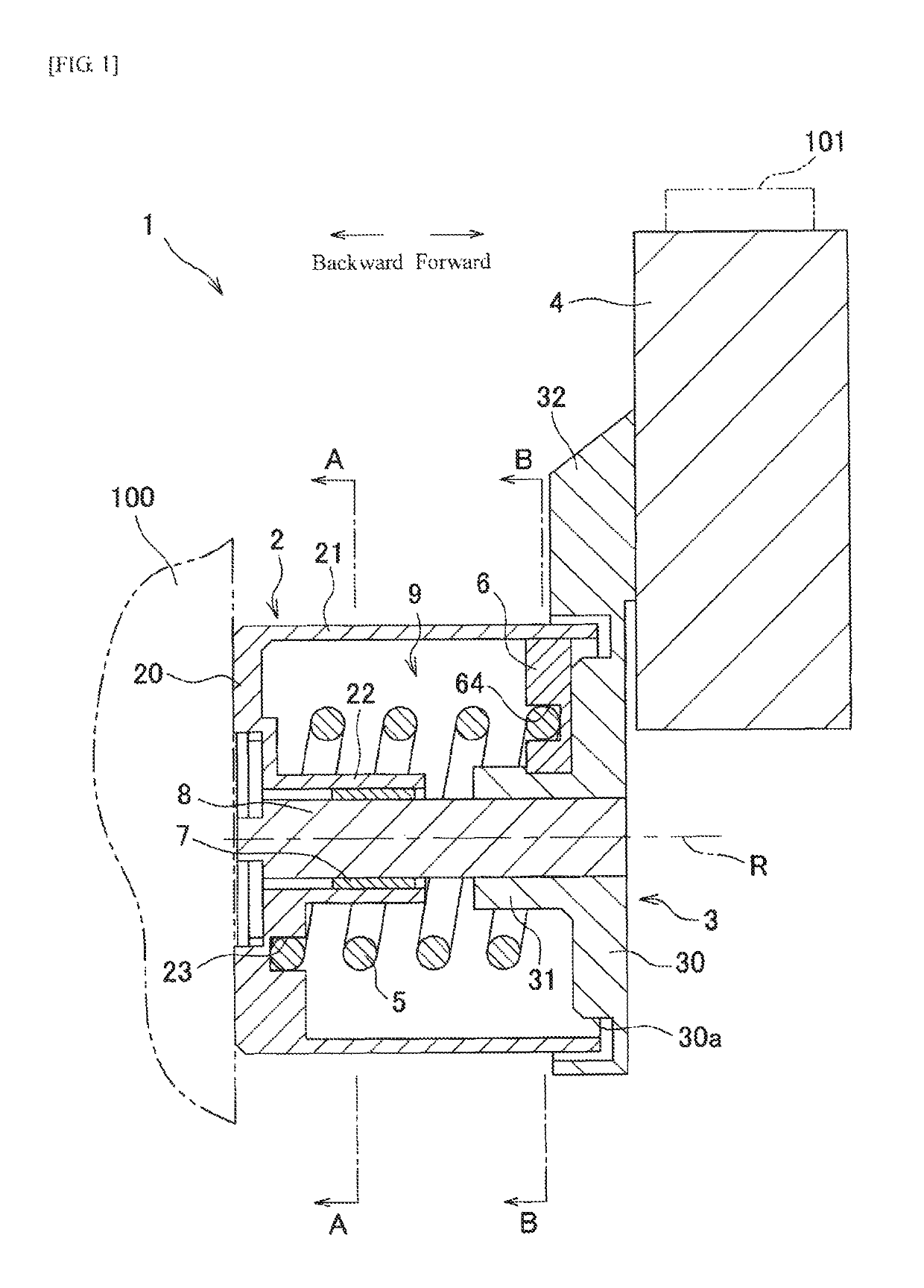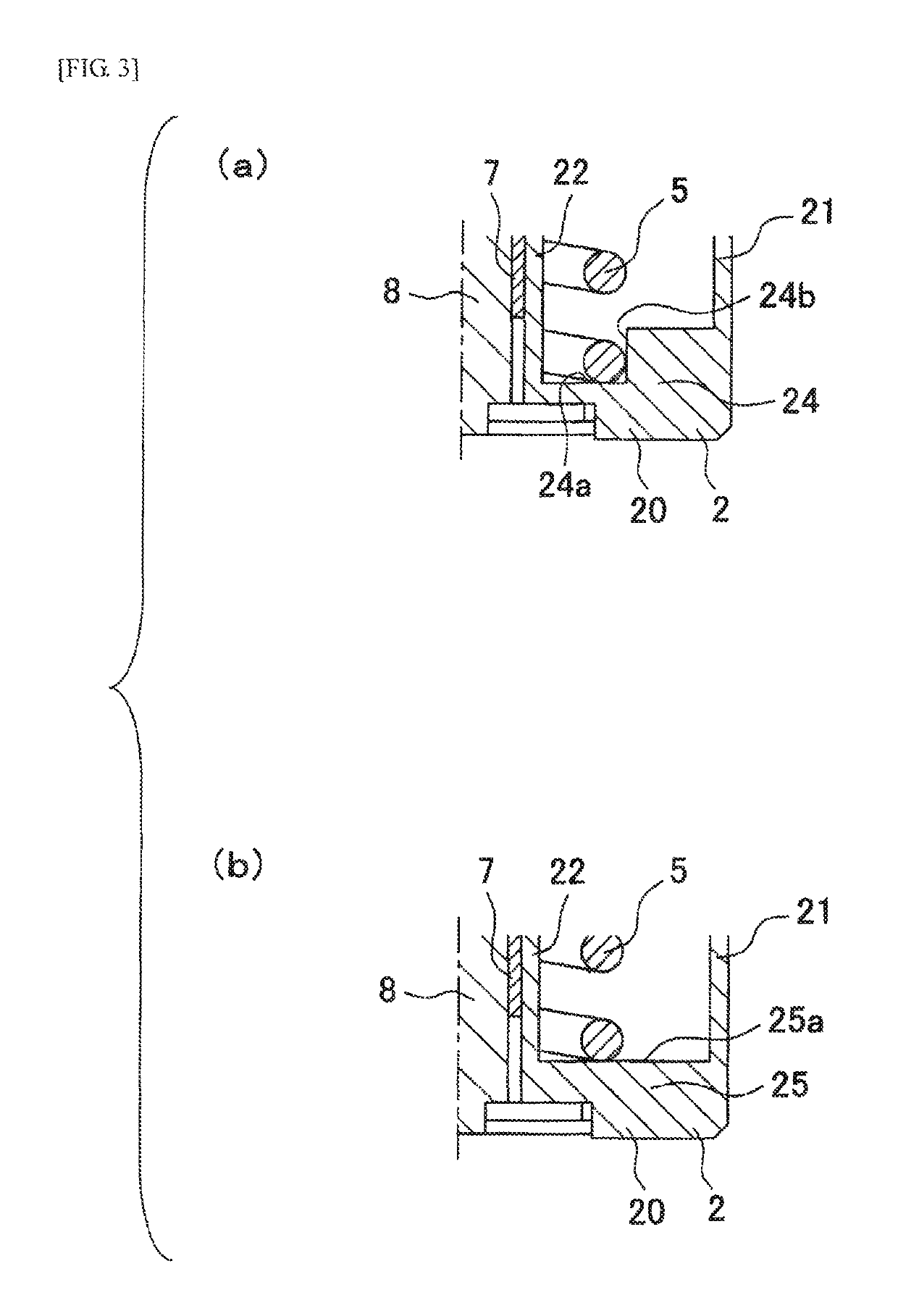Auto tensioner
a technology of auto tensioner and tensioner body, which is applied in the direction of belt/chain/gearing, mechanical equipment, belt/chain/gearing, etc., can solve the problems of belt wear or slippage sound, and achieve the effects of small frictional force, large damping force, and large frictional for
- Summary
- Abstract
- Description
- Claims
- Application Information
AI Technical Summary
Benefits of technology
Problems solved by technology
Method used
Image
Examples
first embodiment
[0047]As illustrated in FIG. 1, an auto-tensioner 1 of the present invention is provided with a base 2 which is fixed to an engine block 100 illustrated by a two-dot chain line in FIG. 1, a rotating member 3 supported so as to be rotatable about an axis R with respect to the base 2, the pulley 4 rotatably provided at the rotating member 3, a coil spring 5, and a friction member 6. The leftward direction in FIG. 1 is defined as a backward direction and the rightward direction is defined as a forward direction. A radial direction centered on the axis R is defined simply as a radial direction and a circumferential direction around the axis R is defined simply as a circumferential direction.
[0048]The base 2 is, for example, a metal part made of an aluminum alloy casting or the like, and is provided with an annular pedestal part 20 which is fixed to the engine block 100, an outer cylindrical part (cylindrical part) 21 extending forward from an outer edge portion of the pedestal part 20, ...
third embodiment
[0060]The friction member 6 is formed of a material having high lubricity, which is obtained by compounding fibers, a filler, a solid lubricant, or the like with synthetic resin. As the synthetic resin configuring the friction member 6, for example, thermoplastic resin such as polyamide, polyacetal, polytetrafluoroethylene, polyphenylene sulfide, or ultra-high molecular weight polyethylene, or thermosetting resin such as phenol can be used. As long as the front face and an arcuate surface 60, which is described later, are configured with the above-described material, the friction member 6 may include a material other than the above-described material (refer to, e.g., a third embodiment).
[0061]The friction member 6 has a substantially fan-shaped cross-sectional shape orthogonal to the axis R and has the arcuate surface 60, a locking surface 61 opposed to the arcuate surface 60, and two side surfaces 62 and 63 opposed to each other in the circumferential direction. The arcuate surface...
fourth embodiment
[0086] since one end of the coil spring 405 does not have a linear portion, the length of the coil spring 405 can be shortened, and therefore, the size of the retention groove (the second locking part) 464 can be reduced, whereby the friction member 6 can be downsized in the circumferential direction (e.g., a portion S illustrated by hatching in FIG. 10 can be omitted). A further reduction in the weight of the auto-tensioner 1 can be realized by the shortening of the length of the coil spring 405 and the downsizing in the circumferential direction of the friction member 6. In addition, since working such as bending one end of the coil spring 405 is not required, simplification of a manufacturing process and a reduction in manufacturing cost can be realized.
[0087]Subsequently, the auto-tensioner 1 of a fifth embodiment of the present invention will be described with reference to FIG. 11. In the first embodiment described above, the front end portion (one end) of the coil spring 5 is ...
PUM
 Login to View More
Login to View More Abstract
Description
Claims
Application Information
 Login to View More
Login to View More - R&D
- Intellectual Property
- Life Sciences
- Materials
- Tech Scout
- Unparalleled Data Quality
- Higher Quality Content
- 60% Fewer Hallucinations
Browse by: Latest US Patents, China's latest patents, Technical Efficacy Thesaurus, Application Domain, Technology Topic, Popular Technical Reports.
© 2025 PatSnap. All rights reserved.Legal|Privacy policy|Modern Slavery Act Transparency Statement|Sitemap|About US| Contact US: help@patsnap.com



